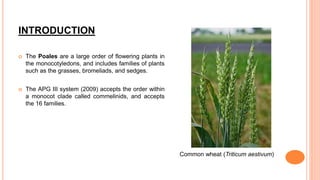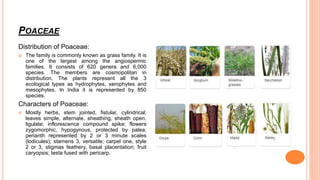The document provides information about the order Poales. It discusses the systematic position of Poales, introducing it as a large order of monocots including families like grasses, bromeliads, and sedges. It describes 16 families within Poales and divides them into 3 groups: the grass group containing 7 families including Poaceae; the cattail group containing Typhaceae and Sparganiaceae; and the sedge group containing Cyperaceae, Juncaceae, and Thurniaceae. It highlights some economically important plants from Poaceae like wheat, millet and sugarcane and discusses the floral structures, affinities and importance of key families like Poaceae, Typhaceae and Cyperaceae.



















